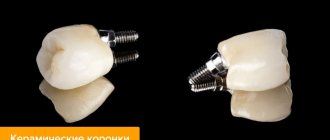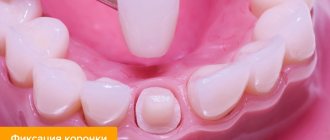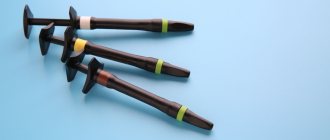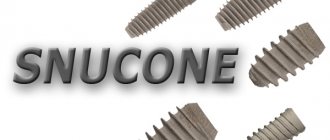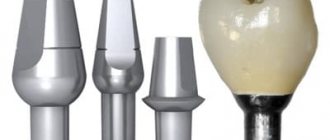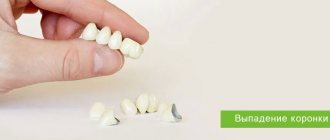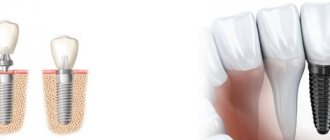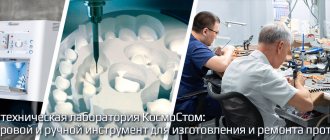- general information
- Compound
- Advantages of the drug
- Flaws
- Mode of application
- Review of manufacturers
- Price
Almost all patients, having decided on artificial restoration of teeth through prosthetics, know little about the materials used during the operation. Perhaps very few people know that there are a huge number of cement composites, each of which is designed for a particular clinical case. What is glass ionomer cement, what are its features and advantages, manufacturing specifics and varieties - this material is dedicated to this.
General information about glass ionomer cement
Glass ionomer cements (hereinafter referred to as GIC) are the latest innovative mixtures characterized by a heterogeneous structural content, where the base part is aluminosilicate glass, and polyacrylic acids act as a polymer matrix.
GIC is the optimal solution for placing fillings on a temporary basis, as well as being used as insulating liners.
Initially liquid in consistency, the mass gradually hardens and takes on the desired state. This happens in several stages:
- dissolution – the process of formation of ions;
- gelation – creation of gel-polymer chains, increase in pH level. The duration of the transition to this state is about 5 minutes;
- complete hardening of the material occurs within 24 hours.
The mixture reacts well with hard tooth tissues, intensely releasing fluoride elements. It is characterized by an average degree of strength, interacts better with enamel than with dentin tissue, and has an inhibitory effect on previously formed caries manifestations.
Installing a crown on your teeth
No matter how badly a tooth is damaged, as long as it has a root, it can be restored. How exactly the restoration is carried out depends on the degree of tooth decay. In case of minor damage, the unit is prepared - the top layer equal to the thickness of the crown is removed. Metal-ceramic crowns consist of 2 layers: metal and ceramic, so they require the deepest preparation. Ceramic crowns are thinner and remove a small layer of hard tissue. Zirconium crowns are thin and require minimal layer removal.
If the upper part is destroyed by 50% or more, then the crown is fixed with a pin. A fiberglass rod is inserted into the canal to serve as a support for the restoration.
Composition of glass ionomer cement
The filling component consists of standard elements for such materials - distilled water and powder mass. As a result of their interaction, they become solid from a liquid state - this is ensured by the influence of acidic processes.
Most often, alkene polymers are used to create GIC:
- maleic;
- polyacrylic;
- itaconic.
They help reduce the viscosity of cement, slow down the process of gelation of the liquid and bind all the elements into a homogeneous mass several times faster. These qualities have a positive effect on the service life of the composition.
The liquid part basically contains distillers or tartaric acid. Powder – calcium silicate glass and calcium fluoride drops.
Upon completion of the filling processes, fluoride ions begin to be actively released into the oral cavity, which is an excellent obstacle to the development of secondary caries manifestations. The silicate substance is necessary for proper acid reactions to occur. Mineral substances in contact with glass form a silicon film, which is subsequently impregnated with acidic masses. In this case, the processing time becomes shorter, and the hardening time, on the contrary, becomes longer. The same principle is used to ensure hygroscopic reduction.
Stages of manufacturing a metal-ceramic bridge prosthesis
The main indication for prosthetics using fixed bridges is the absence of one or more teeth.
If you have a problem similar to that described in this article, be sure to contact our specialists. Don't diagnose yourself!
Why you should call us now:
- We will answer all your questions in 3 minutes
- Free consultation
- The average work experience of doctors is 12 years
- Convenient location of clinics
Single contact phone number: +7
Make an appointment
Dental prosthetics using fixed metal-ceramic prostheses is one of the most common methods of treating violations of the integrity of the dentition and restoring chewing function. For this purpose, missing teeth are replaced with artificial ones, supported by adjacent teeth. The functional basis of such treatment is the reserve capacity of the dentition, which allows it to withstand additional load.
A fixed metal-ceramic bridge prosthesis is a structure consisting of one or more artificial (metal-ceramic) teeth rigidly attached to adjacent natural teeth using fixing elements - metal-ceramic crowns.
Typically, the number of supports in a bridge is two, but sometimes there is a need for three or more supports. Due to the fact that the supporting teeth experience pressure not only directly on them, but also on the intermediate part of the bridge, the number of replaced teeth cannot be too large. As a rule, this is 1-2 teeth.
The manufacturing process of a metal-ceramic bridge consists of clinical and laboratory stages.
Clinical stage
After the examination, if necessary, preliminary treatment is carried out: gum treatment, filling of supporting teeth and, if this is unavoidable, removal of the pulp and filling of root canals.
Then the teeth are prepared, on which the crowns that are part of the metal-ceramic bridge will be placed. This stage consists of grinding down their convex surfaces that prevent the crown from being put on.
After processing the teeth, an impression is taken and a plaster model of the missing dentition, along with data on the state of the bite, is sent to the dental laboratory.
Laboratory stage
In the laboratory, jaw models are made, on which the frame of the bridge is formed from wax, and then the metal frame is cast in a foundry.
Then the frame can be coated with a golden sublayer, which, due to the high gold content, allows the ceramic mass to be applied in an ultra-thin layer, through which the black or dark gray color of the oxide film covering the surface of the metal frame will not show through.
Next, the frame is covered with ceramic mass. The ceramic coating is applied in layers in accordance with the colors selected by the orthopedic surgeon. The “face bow” data is transferred to the articulator and the bridge is finally modeled in shape, taking into account the bite and relationship of the teeth during movement.
A bridge is a rather complex structure, so another intermediate visit is required - fitting of the frame. During the third visit, the final correction is made. The ceramics are covered with glaze, which gives the prosthesis a natural look, and with the help of special cement, the metal-ceramic prosthesis is fixed to the teeth.
Advantages of glass ionomer cement
Glass ionomers have the following advantages, in comparison with analogue filling materials:
- ease of use - cement fills the cavity in one or two portions. Its use does not involve the processes of preliminary etching of the area and bonding of dentin;
- the unique property of hardening even in a humid environment - this quality ensures the active use of the composition in the treatment of caries cavities in the cervical zone, elimination of wedge-shaped pathologies, as well as caries, the affected area is the area located below the gum level;
- connection of the component with the tissues of dentin and enamel according to the intermolecular principle - makes it possible to install fillings with excellent marginal fit and eliminates the need to create retention areas during the treatment of the organ;
- complete adhesion to compositions with clove oil - thus, GIC is used as insulating liners that protect fabrics from excessive attachment of composites to them;
- adhesion to metal components;
- the ability to release ion enzymes into the organ cavity for at least a year after the filling is installed;
- weak shrinkage during polymerization - at the moment of transformation into a solid state, cement slightly increases in volume, which partially compensates for shrinkage processes;
- no irritating effect on dentin and pulp tissue - their composition is not aggressive and not dangerous in the treatment of deep caries if cement is used as a spacer;
- the thermal expansion indicator corresponds to the coefficient of expansion of the organ tissue - in such a situation, the filling is fixed more reliably, lasts longer, and its marginal fit is an order of magnitude better. This is a good preventive protection against the formation of damage to the enamel surface - cracks, chips.
Prosthetics on implants
Crowns are secured to implants in 2 ways: with cement or a screw
. This depends, first of all, on the type of implantation and the implant models that are used. But anatomical features and clinical manifestations play a big role.
Cement fixation of crowns on implants has its pros and cons. The process of attaching a restoration to an implant using cement is not much different from prosthetics on natural teeth. It is simple, well studied, and allows fixation in complex cases where a screw fixation would require enormous effort and skill.
The disadvantages include the possibility of peri-implantitis, which can be caused by excess cement. When using cement, the crown cannot be repaired, only replaced.
Screw fixation of crowns to the implant prevents cement from getting on the tissue. There is a possibility of repair and correction. The results of joining metal to metal without a cement layer are better. The single design of abutment and crown reduces the risk of infection.
However, the fitting of a screw-fixed prosthesis is more delicate, requires certain skills, and the price of designs with screws is higher.
This is why choosing a doctor is so important. A qualified implantologist takes into account dozens of details before choosing an implantation method, which determines whether the crown will be screw-fixed or cemented, and an experienced orthopedist knows how to work with both.
Disadvantages of glass ionomer cement
The material is not without its shortcomings, some of which are quite significant:
- long maturation of the cement composition - it completely hardens only a day after installation, despite the fact that the first setting occurs within a few minutes;
- in the first hours the mixture is sensitive to a humid environment - it is at that stage that active leaching of ions occurs, which slows down the processes of final polymerization;
- poor resistance of the structural content to mechanical vibration - the material cannot be affected by a conventional drill immediately after installing the filling;
- etching of organ tissue is unacceptable;
- limited use for complex caries with a deep damaging effect;
- poor resistance to diametric tension, which completely excludes the use of GIC for the treatment of occlusal surfaces, as well as in clinical situations when the load on the tooth is distributed in different directions;
- shorter service life compared to conventional cement composite;
- average level of aesthetics, which limits its use on the frontal areas of the jaw row.
The nuances of installing metal-ceramic dentures: consultations with Berezki dentists
Patients who decide to restore the fullness of their dentition with metal-ceramic products should know that there are different types of structures. They differ from each other in terms of strength and reliability, aesthetic characteristics, service life and price.
You need to understand that to achieve a positive effect, it is not enough to simply choose the most expensive products. It is very important to carry out the preparatory procedures correctly and efficiently:
- sanitation of the oral cavity;
- treatment and filling of root canals if they are preserved;
- grinding of dental units.
After therapeutic manipulations, a control X-ray examination is required to prevent negative consequences. Only after making sure that the preparatory stage has been completed flawlessly does the doctor begin taking impressions from which the crown is made.
Method of using glass ionomer cement
The algorithm for using standard glass ionomer cements is as follows:
- thorough treatment of the working area with a conditioning liquid, which is washed off 20 seconds after application and the cavity is well dried;
- the damaged tooth is isolated from moisture and salivary secretions for the entire period of setting of the mass - about 5 - 6 minutes;
- the liquid and powder composition are mixed until a shiny, homogeneous thick mass is obtained;
- they place it in the organ cavity and form a filling, while ensuring dense condensation using a cotton swab or a special device with a spherical movable working tip;
- after giving the filling the desired shape, its relief is coated with varnish;
- after 1 – 2 days, treat with a drill. After this, the tooth can function normally.
General overview
The structure of glass ionomer cement is a combination of a thermoplastic polyacrylic polymer and a silicate system. The practice of using the composition confirms the functionality of the new material, which is significantly superior to standard adhesive compositions based on phosphate and polycarbonate with the addition of zinc. Within the framework of the accepted classification, three main criteria are used to differentiate existing types of GIC:
- Based on the purpose of use, materials are selected for securing dentures and orthodontic correctors, strengthening the structure of teeth, fixing aesthetic fillings and onlays, as well as ensuring a tight fit of restoration elements;
- From the point of view of the release form, powder, capsule and paste cement is divided, supplied in ready-to-use form;
- Based on the mechanics of polymerization, a distinction is made between compositions that harden under the influence of light, as well as as a result of chemical interaction with water.
The choice of material for prosthetics is determined by the indications of the clinical picture formed based on the results of preliminary diagnostics.
Overview of glass ionomer cement manufacturers
Despite the fact that the composition of the GICs of the main manufacturers is almost identical, the following line of leading manufacturers are distinguished in the domestic market of dental materials, firmly holding the rating for a long period of time. It is advisable to consider the features in more detail.
Arde Kwik Tsem
It is a fluid hybrid mixture of a double solidification principle. Ideal for attaching veneers, bridge devices, and inserting pins during restoration with implants.
Thanks to its unique structural content and viscous consistency, it ensures the highest quality filling of the tooth cavity.
It has a serious disadvantage - it can provoke individual intolerance and cause allergic reactions of varying degrees of intensity.
Arde Fix
It is used for permanent fixation of orthodontic and prosthetic devices. Not prone to dissolution and oxidation in the oral cavity. If the composition is mixed correctly, side effects and complications are completely excluded. May cause a short-term decrease in the sensitivity of taste buds, which resolves spontaneously after some time. It does not tolerate the presence of eugenol elements in the work area.
Fuji Plus
A distinctive feature of the mixture is its modification with a composite, which provides a number of advantages:
- stronger fixation;
- possibility of use when interacting with metal, non-metal, ceramic prosthetic structures of all types in the process of orthopedic manipulations.
The disadvantage is the weaker light reflectivity of the material in the solid state.
Ketak Tsem
The main advantage is simplicity and ease of use. Shorter time for manual mixing and bringing to the required consistency.
It has high aesthetic indicators - a matte, slightly silky surface, which is especially important when working on the frontal area of the jaw.
The disadvantage is sensitivity to low temperatures, which increase the hardening time.
Tsemion F
The composition has good radiopacity, withstands high mechanical loads in comparison with analogue products, and has a low solubility index.
Adhesive to enamel and dentin tissues.
Allows you to achieve a high level of marginal sealing, releases fluoride over a longer period of time, which helps strengthen tooth enamel. It has a low pain sensitivity threshold and causes virtually no discomfort in patients during the rehabilitation period after treatment.
Indications
Indications for restoration:
- significant destruction of the coronal part;
- installation of bridges;
- pathological abrasion of enamel;
- depulpation;
- injuries.
Crowns are made of metal, ceramics and metal-ceramics. Porcelain and plastic crowns are practically not used due to their fragility. Modern materials are particularly durable and wear-resistant. They are designed for long-term use. But the service life, as well as the convenience of the crown, also depends on how well it fits and how firmly it is secured.
Glass ionomer cement price
Depending on the manufacturer, the cost of cement of various brands looks something like this:
Arde Kwik Cem – from 1,300 rub.
Arde Fix – from 1,420 rub.
Fuji Plus - from 1,520 rub.
Ketak Tsem – from 1,380 rub.
Tsemion F – from 1,240 rub.
Having placed a filling from the material discussed in this article, you don’t have to worry that after a short time it will crumble under temperature or mechanical influence. And although in some respects cement is inferior to more expensive mixtures, with proper use the tooth will retain its functionality for a fairly long period of time.
Aesthetic properties of metal ceramics
Metal-ceramic crowns have excellent aesthetic qualities. Modern technologies make it possible to achieve any shade of ceramic coating color.
In the 60s and 70s, there was a fashion for the so-called “Hollywood smile”, to create which metal-ceramic dentures with straight white teeth were made. Despite its external attractiveness, the “Hollywood smile” is unnatural, lifeless and, with rare exceptions, does not match the remaining teeth.
Increasingly, patients began to express wishes that artificial teeth would not differ from the preserved natural ones. But the possibilities of materials for the manufacture of metal-ceramic dentures were then very limited.
This led to the emergence of a number of research projects aimed at developing dyes, effect masses, opalescent porcelains, etc. A revolutionary step in the development of materials for creating natural aesthetics in dentures was the creation of the internal coloring technique, developed by one of the world's most famous dental technicians, Hitoshi Aoshima. The principle of this technique is that all the characteristic features of the tooth are not drawn with dyes on the surface of the metal-ceramic prosthesis, but are modeled from the inside.
Luster (glossy) porcelain was also developed. Research scientists have come to the conclusion that tooth enamel, in its shine, resembles the surface of a pearl. To imitate the natural shine of enamel, scientists have created a new technology for producing opalescent materials. The surface of luster porcelain, thanks to the ultra-fine structure of the particles, resembles the enamel of a natural tooth in its relief, ability to transmit light and color.
If the metal ceramics nevertheless turn black, then the reason for this may be trivial - the patient forgets to brush his teeth. If the lowest layer of ceramic, opaque, does not sufficiently dampen the metal frame and allow chromium ions to pass through (in the case of a cobalt-chromium alloy), then they give the accumulated plaque an unpleasant greenish tint. Individual oral hygiene is very important for everyone, and especially for those who have metal-ceramic dentures.
